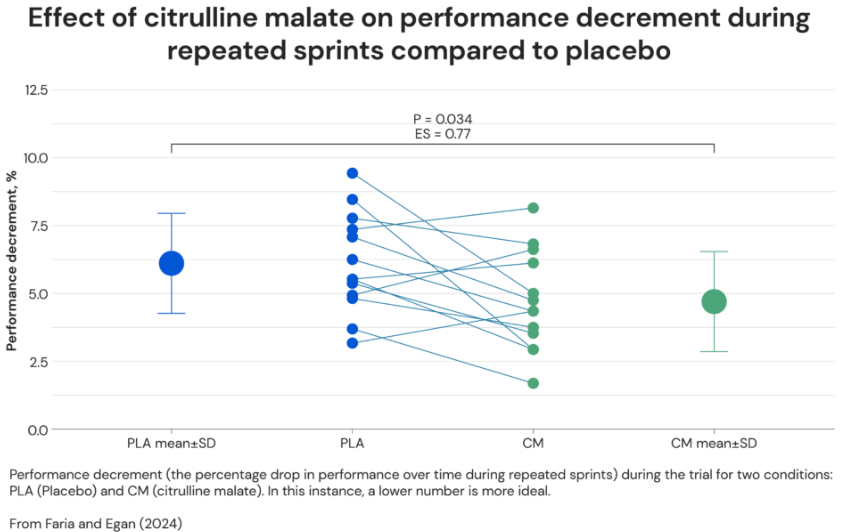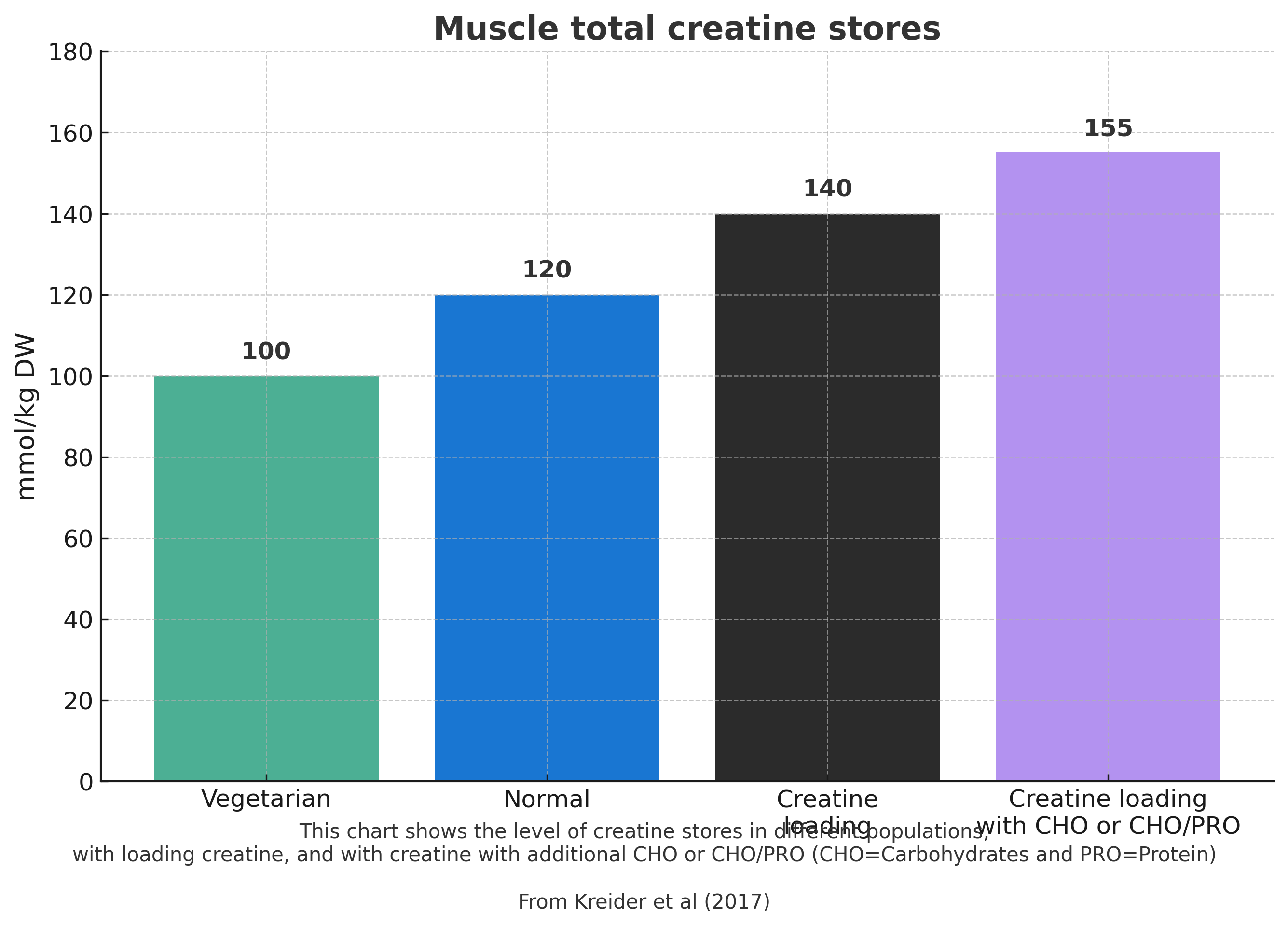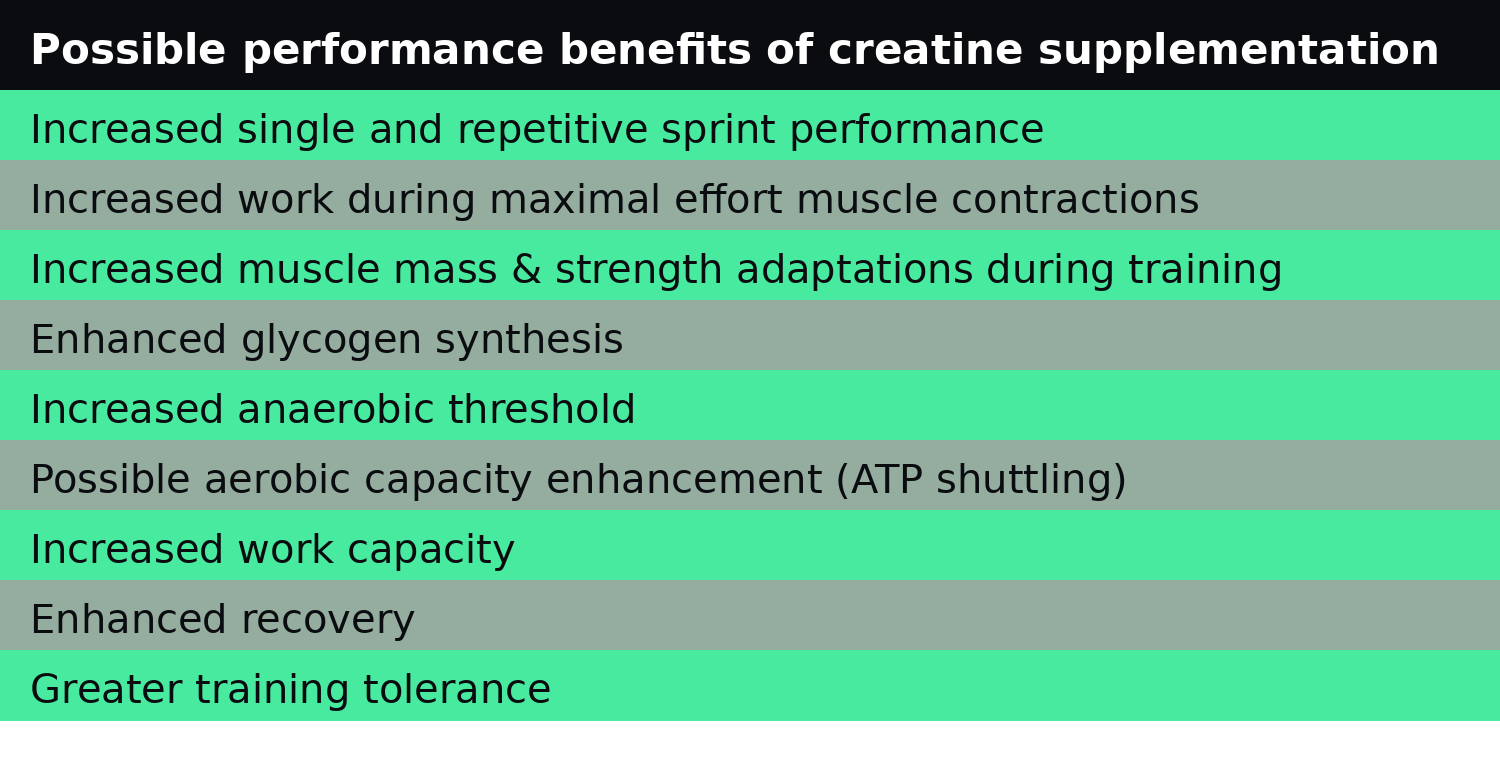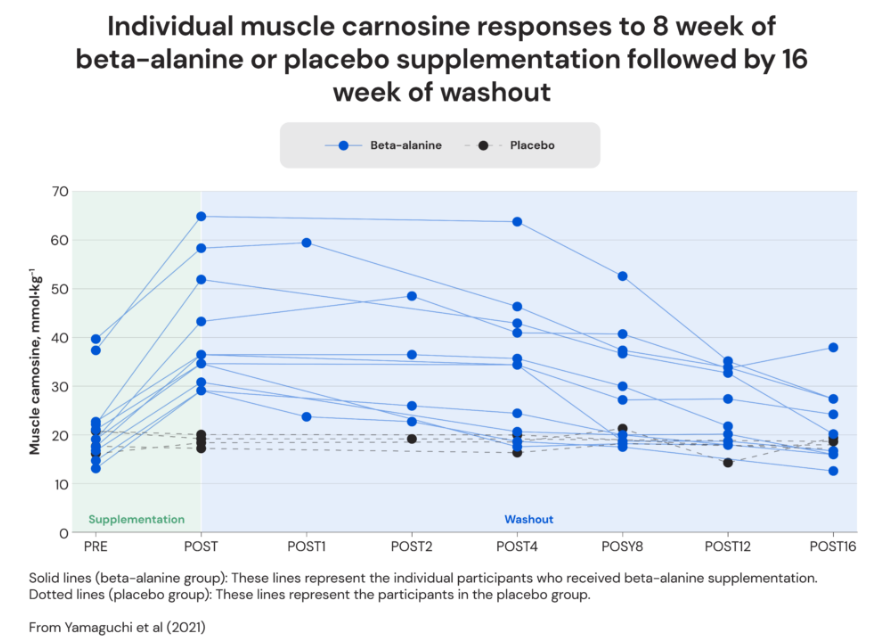In the first part of our supplement trilogy, we examine those related to performance and which have the strongest scientific support.
Introduction
This is the first of three articles in our series that explores dietary supplements and their value in three key areas:
- Athletic performance
- Body composition
- General health
In this article, we focus exclusively on those supplements with the strongest scientific evidence for enhancing athletic performance. We’ll explore how they can be incorporated into your routine with practical applications and minimal side effects.
Let’s get started!
What Is Defined As a Dietary Supplement?
According to the Dietary Supplement Health and Education Act (DSHEA) of 1994 in the United States, a dietary supplement is any product designed to supplement or enhance your diet. It may contain one or more of the following:
- an amino acid
- an herb or other botanical
- a vitamin
- a mineral
- a dietary substance used to increase total daily intake
- a concentrate, metabolite, constituent, extract, or combination of the above
Once a substance is classified as dietary, it must meet the specifications outlined by DSHEA. These include proper labeling, ingredient listing, and clear indication of amount and use. However, the products themselves are not subject to independent review before reaching the market.
Government agencies like the FDA and the FTC oversee these products after they are released to the shelves. They are responsible for evaluating product safety, the presence of banned substances, and preventing misleading claims.
Understanding Performance Supplements
In this article, we focus exclusively on supplements that enhance physical performance. Supplements related to improving body composition or overall health will be covered in future articles.
The concept of “performance” is quite broad. It doesn’t only refer to athletic activity itself (e.g., how well you run), but also to recovery afterward. There is a clear overlap with muscle growth, as increased muscle mass can improve performance. However, muscle growth is also directly related to body composition, which we will analyze in the next article.
For simplicity’s sake, this article focuses exclusively on performance.
Acute vs. Chronic Effects of Supplements: What’s the Difference?
When evaluating supplements, it’s important to distinguish between short-term (acute) and long-term (chronic) effects.
Simply put, acute effects appear quickly — usually within minutes to hours after taking the supplement. They’re ideal for situations where you need immediate results, such as before an intense workout.
In contrast, chronic effects appear gradually, over days, weeks, or even months, as the body adapts over time. The change is slower, but usually more stable and sustainable.
It’s also worth noting that immediate effects do not necessarily imply long-term improvement. For example, caffeine may give you a boost for a strong workout, but studies don’t show it automatically contributes to long-term progress.
The smartest approach is to combine strategies: use acute supplements for instant performance while also working with those that build long-term results. That way, you can win on both fronts.
Choosing Supplements: What Research Shows vs. What Works in Practice
When evaluating performance supplements, the goal is to identify those that combine strong scientific evidence with measurable results. Ideally, the research should be rigorous and the benefits clear — not just in lab settings, but also in real-life training or athletic performance.
To keep things simple and clear, we’ll divide supplements into two main categories:
Top-Tier Performance Supplement: Protein Powder
Out of all the supplements discussed in this article, protein and carbohydrate supplements are perhaps the most logical and evidence-based. Still, interpreting the research around them can be somewhat complex. Why? Because they are macronutrients that provide calories. Essentially, they are sources of food and energy, something many overlook when seeing protein powder as “something else.”
Even if protein powders contain added ingredients, at their core, they are sources of protein — whether whey, egg, soy, or other plant- and animal-based forms. They are available in powder form, ready-to-drink shakes, or “ready-to-eat” products.
Protein is extremely important for tissue growth and repair and for nearly every function in the body. If you’re unsure how much protein you need daily, you can check a related article, but the core message is simple: protein is essential.
Ideally, your daily protein intake should come from whole foods, whether animal or plant-based. These foods also offer valuable nutrients such as micronutrients and antioxidants, which are not necessarily included in a protein shake.
However, research clearly shows that protein supplements can be very helpful when we struggle to meet our needs — whether due to health reasons or intense training. The scientific debate gets more complex when considering whether additional protein from supplements provides acute (immediate) or chronic (long-term) benefits for performance and recovery.
In a systematic review and meta-analysis of 49 randomized trials, it was shown that adding protein supplements improved muscle mass and strength in people undergoing resistance training. Specifically, 1RM (one-rep max) strength increased by an average of 2.49 kg — about a 9% improvement. However, the same study emphasized that if you’re already meeting your protein needs through food, supplements aren’t necessary.
There are many successful studies showing positive effects of protein supplements on performance [1], [2], [3]. But the real question is: do you actually need them?
Takeaway: If supplements help you meet your daily protein needs or support your workout-related intake, then they may be the most useful supplement in your toolkit. But if you’re already eating enough protein from food, then there’s no need for anything extra.
Creatine: The #1 Performance Supplement
Creatine belongs to the “pure” category of supplements. It is considered the most effective and well-studied supplement for athletic performance — and for good reason. Its reputation isn’t just hype; the scientific backing is clear.
It is a compound formed from three amino acids: arginine, glycine, and methionine. Our body naturally produces it, so we have creatine in our system even if we don’t take a supplement.
However, diet affects how much we get daily. For example, people on a meat-based diet consume around 1 to 2 grams of creatine per day through food. In contrast, vegetarians usually have lower stores since creatine is mainly found in animal products. The exact amount depends on how much and what kind of animal foods are included in the diet.
How to Take Creatine and How It Works
There are two main ways to take creatine: the loading phase and the gradual approach.
The loading phase involves taking 20 to 25 grams per day for 5 to 7 days. The goal is to saturate muscle stores as fast as possible. After loading, the dose is reduced to 3 to 5 grams daily for maintenance. While many prefer this method for speed, it can cause stomach discomfort, which isn’t pleasant for everyone.
The alternative is the gradual intake method, where you take 3 to 5 grams per day from the start, without a loading phase. It may take about a month to reach full saturation, but most find this option much more digestive-friendly.
In the end, the choice comes down to personal preference.
How Creatine Enhances Performance
Creatine boosts performance mainly by increasing phosphocreatine levels, a substance that helps regenerate ATP — the body’s primary energy currency. Without diving deep into biochemistry, this means you can “spend more energy” in short, intense efforts like explosive sets or sprints. This translates to more reps or total training volume in a single session.
There are also other potential mechanisms of action, such as the reduction of oxidative acidosis — that “burning” or fatigue sensation you feel during intense workouts.
In terms of strength, creatine appears to have positive effects on both the upper and lower body, and there is evidence that it also supports faster recovery after exercise.
We’ll talk more in-depth about muscle growth in the next article on body composition, but it’s worth noting that maintaining or increasing muscle mass is in itself a significant factor for performance.
Not Everyone Responds the Same to Creatine
It’s worth noting that not everyone responds the same way to creatine — and there are good reasons for this. One of the most logical explanations is that some individuals already have “saturated” creatine stores in their bodies before they even begin supplementing.
The amount of creatine in muscles varies from person to person. Some have lower levels, others naturally have higher levels, depending on their diet and physiology. People with lower muscle creatine stores are the ones who benefit the most from supplementation, especially in terms of performance.
In general, creatine is considered a safe and very well-researched supplement. It has minimal side effects — and those that do occur, such as stomach discomfort, can often be avoided by choosing the gradual loading method.
In summary: creatine is a supplement worth considering. It’s not a miracle, but for many, it’s the most effective aid they can add to their program.
Carbohydrate Supplements: Energy Where It’s Needed
Like protein supplements, carbohydrate supplements are sources of calories. In this article, we focus on their role in performance.
When you consume carbohydrates, your body breaks them down into glucose, which is used as the main fuel during exercise. Carbs are especially efficient because under aerobic conditions they produce more ATP (more available energy) per unit of oxygen compared to other fuels. When blood glucose is depleted, the body turns to glycogen stores to continue fueling exercise.
Consuming carbohydrates before or during training helps maintain glycogen levels and circulating glucose, which contributes to more stable and efficient performance, especially in long or high-volume sessions.
A massive meta-analysis covering more than 45 years of research, 96 studies, and 142 experiments, concluded the following:
The longer the duration of exercise, the more effective carbohydrate consumption becomes.
In fact, it was shown that consuming carbohydrates during exercise was more beneficial than consuming them beforehand — especially during prolonged efforts.
Carbohydrates: Which Form and When?
There’s no single protocol used across all studies. However, some forms of carbohydrates are more popular, such as hydrogels (carbohydrate gels) and sports drinks. In most cases, the common mix used is glucose and fructose in a 2:1 ratio.
Another interesting finding from the meta-analysis was that cyclists seem to benefit more from carbohydrate supplementation compared to runners. But this doesn’t mean everyone should do the same. The type of training you do and your goals play a crucial role in whether focusing on carbohydrate intake during training makes sense.
For example, people training with weights are unlikely to see significant benefits from immediate carbohydrate consumption, compared to endurance or prolonged-duration sports.
One might ask: where does food end and supplementation begin? Good question. The answer depends on your context and needs. Sometimes supplements are more practical, especially under demanding conditions or before/during competition. Other times, whole foods are the best choice — especially for lighter or everyday training sessions.
As always, the answer lies in your context and personal needs.
Caffeine
Caffeine deserves a special mention. While technically not a dietary supplement but a natural substance with pharmacological action, it’s often included in many products targeting performance enhancement.
It belongs to the class of methylxanthines, a group of alkaloids with stimulating effects. Its main mechanism is that it blocks adenosine receptors in the brain, which leads to increased alertness and reduced perception of fatigue. This mechanism appears to be the most decisive for its performance-enhancing effects.
Caffeine can lead to:
- lower pain perception
- stronger muscle contractions during anaerobic exercise
- improved cognitive function during training
Beyond adenosine, it also appears to affect other mechanisms. For example, it may increase calcium release in muscle cells, enhancing contraction. Some studies show that caffeine boosts nitric oxide production and the action of dopamine, which might explain its even greater impact on performance.
A large umbrella review analyzing 21 meta-analyses showed that caffeine has a greater effect on aerobic forms of exercise (e.g., running, cycling), although it also helps with anaerobic activities. In fact, performance improved across all types of exercise, with varying degrees of intensity.
How Much Caffeine Is Enough? And How Much Is Too Much?
Most studies included in the aforementioned meta-analysis used doses around 6 mg per kilogram of body weight. Generally, caffeine’s effective range appears to be between 3–6 mg/kg. Below 3 mg/kg, the benefits are limited; above 6 mg/kg, the chances of side effects increase, such as tachycardia, nervousness, or stomach issues.
Let’s see what that looks like in real terms:
If we choose a moderate dose of 4 mg/kg, then for a person weighing 70 kilograms:
70 kg × 4 mg = 280 mg of caffeine
That’s roughly equivalent to 2 to 3 large cups of coffee. Of course, this number is relative. For some, it’s too much — especially if they’re sensitive to caffeine. For others, it’s the… absolute minimum required to open one eye in the morning.
Personally, I’m sensitive: I need very little caffeine to feel the effect. Others I know (no names mentioned) could have a caffeine IV drip and still sleep like babies.
The bottom line is that caffeine works. The key is to find what works for you. Start with small amounts, try different sources — coffee, green tea, caffeinated drinks or powders — and observe how your body reacts. There’s no need to overdo it; just find your own balance.
Mid-Tier Supplements: Smaller Benefits, Fewer Side Effects
As we’ve seen so far, the core supplements we discussed have strong scientific backing and a clear effect on performance. In this section, we’ll move on to a mid-tier group of supplements that fall into three general categories:
- Supplements that show promise but need more research
- Supplements that have milder effects or don’t yet have sufficient scientific support
- Supplements that might be worthwhile for specific needs or situations, despite their limited general application
If you enjoy experimenting with supplements and are looking for ways to improve your performance through relatively safe means, this section will definitely pique your interest.
Beta-Alanine: Small Effect, Big Interest
Beta-alanine is a non-essential amino acid, meaning our body can produce it on its own and it’s not mandatory to obtain it from food. However, supplementing with it has gained particular interest in recent years, mainly due to its impact on carnosine levels in muscles.
Carnosine is a dipeptide (i.e., two joined amino acids) found in high concentrations in muscles and helps neutralize the acidity produced during intense exercise. This function can delay the onset of fatigue, allowing you to push a bit further, especially during high-intensity training.
And you might be wondering: why not just take carnosine directly? A fair question, but oral absorption of carnosine appears to be less effective and may come with unwanted side effects. That’s why the common approach is to take beta-alanine as a precursor, so the body gradually increases its carnosine stores.
A common mistake is using beta-alanine only through pre-workout supplements, taken sporadically. In this case, it’s very likely that you won’t see any effect, since beta-alanine only works effectively when taken consistently over the long term.
Studies show that muscle carnosine levels increase based on the total cumulative amount of beta-alanine you’ve consumed. To reach maximum saturation, approximately 1,500 grams of total intake are required. If you’re only taking 5–6 grams before training, it will take you… months. But if you take 10g daily, every day, you can reach the desired levels much faster.
A meta-analysis by Rezende et al. confirmed that nearly 99.3% of individuals respond positively to beta-alanine, regardless of gender. A second meta-analysis found that beta-alanine offers a mild but real benefit in sports that fall between aerobic and anaerobic intensity. Finally, a study by Yamaguchi et al. showed that when supplementation stops, muscle carnosine levels return to baseline in about 16 weeks.
So, if you really want to benefit from beta-alanine, you need consistency and patience — not just a pre-workout before leg day.
So, Is Beta-Alanine Worth It?
It’s now safe to say that supplementing with beta-alanine increases carnosine levels in muscles, which can offer small but consistent performance benefits across various populations. The results appear to be more noticeable in efforts lasting from 30 seconds to 10 minutes, meaning types of exercise that are medium-duration and high-intensity.
In contrast, there’s no evidence that it significantly helps in long-duration endurance sports, nor in heavy sets with few reps, as typically seen in maximum strength training.
For beta-alanine to work properly, it needs consistent (long-term) supplementation, not just 1–2 doses during the week before workouts. The logic of “I only take it on leg day” simply… doesn’t work.
From a safety perspective, beta-alanine is generally well tolerated, with minimal side effects. The most common is a “tingling” sensation (paresthesia), which is not dangerous and usually subsides easily if the dose is split throughout the day.
Finally, there’s growing interest in the combination of carnosine with anserine, aiming to reduce the discomfort caused by carnosine, but for now, beta-alanine remains the simplest and most effective solution.
Sodium Bicarbonate (Baking Soda): Emergency Boost for Endurance
After beta-alanine, sodium bicarbonate is another supplement that helps regulate pH and reduce muscle fatigue, although it works in a different way. You may not have associated it with exercise until now, but you already know it — it’s what we commonly call baking soda.
Unlike beta-alanine, bicarbonate does not require long-term intake. It works immediately by increasing the pH in the blood and intracellular fluids, neutralizing the excessive acidity produced during intense exercise. The result? Less fatigue and usually a bit more performance in duration or repetitions.
A meta-analysis of 20 studies showed that bicarbonate intake improved muscular endurance. The dose used in most studies was 0.3g per kilogram of body weight, taken 60 to 180 minutes before exercise. However, the same study showed minimal or no benefit in strength-based exercises. As always, the type of training is crucial in determining whether the supplement is worthwhile.
But there’s a catch: consuming bicarbonate can cause gastrointestinal discomfort, especially if the dose is high and taken all at once. A more user-friendly approach is to split the dose throughout the day. For example, instead of 0.3g/kg in one dose, you can take 0.1g/kg three times during the day, with a lower chance of discomfort.
It doesn’t affect everyone the same way, but it’s common enough that it’s worth considering before trying it. If you overdo it, chances are… your workout will find you in the bathroom.
Conclusion: Sodium bicarbonate can be useful for intense efforts of duration when you need a bit of an extra push. Just start carefully.
Citrulline Malate: Circulation, Endurance, and Less Fatigue
Citrulline Malate (or CitMal) is a combination of two compounds: L-citrulline, a non-essential amino acid, and malic acid, which plays a role in the Krebs cycle — the process through which our body produces energy.
CitMal is mainly studied for its potential to:
- increase nitric oxide (NO) levels
- improve blood circulation
- reduce perceived fatigue during exercise
L-citrulline on its own has been shown to enhance blood flow, but combining it with malic acid may provide additional benefits, since malic acid is associated with energy production and reduced lactic acid — leading to less muscle fatigue.
As promising as the data may seem, the overall research on CitMal remains relatively limited. Moreover, many studies don’t clearly differentiate between L-citrulline and citrulline malate, making evaluations more difficult.
A meta-analysis by Rhim et al. included both forms and found a small but positive effect on reduced perceived effort during exercise.
More specifically, Vårvik et al. analyzed 8 studies on CitMal’s effects on strength endurance when taken 40–60 minutes before exercise. The results showed a moderate improvement in the ability to maintain intensity across repeated sets.
Even more recently, in a 2024 study, participants who took 8g of CitMal for 3 days showed less performance drop-off during short but repeated sprints.
So, What Can You Expect from Citrulline Malate?
Citrulline malate appears promising. It has minimal side effects, mixes easily into drinks, and is convenient for most people. These characteristics make it a good choice for those seeking an extra boost in training without complicated instructions.
However, it’s worth noting that we’re still in the early stages of research. The initial findings are certainly encouraging, but we need more studies, especially long-term, to fully understand the range and consistency of its effects.
In short: If you want something mild, easy, and promising, CitMal is worth a try — as long as you’re not expecting… miracles in the first week.

Beetroot Juice: Natural Boost of Nitric Oxide and Endurance
Raising nitric oxide levels in the body isn’t limited to amino acids or synthetic supplements. A more natural and particularly interesting way is through beetroot juice, which contains nitrates. After consumption, these convert into nitric oxide, enhancing circulation and muscle oxygenation.
Nitric oxide dilates blood vessels, improving blood flow and increasing oxygen delivery to the muscles. This can make muscle contractions more efficient, enhancing aerobic performance and endurance.
A systematic review of 23 studies focusing on athletes showed that beetroot juice offers substantial benefits for endurance sports, and there is additional potential for use at high altitudes due to its ability to perform better in low oxygen conditions.
To see an effect, the typical required amount of juice is around 500 ml, which provides about 6–8 mmol of nitrates. Nitric oxide levels peak 2–3 hours after consumption, so the ideal intake time is 90 to 150 minutes before exercise.
However, there are also minor interactions worth noting. For example, caffeine may reduce the potential benefits of beetroot juice. Even more surprisingly, using mouthwash can reduce its effectiveness, as it kills the oral bacteria that help convert nitrates into nitrites (and ultimately into nitric oxide).
Still, beetroot juice is well tolerated, with minimal side effects, and is considered a natural, safe addition for anyone looking to improve performance.
Let’s Summarize…
Protein (powder or drink):
Essential for recovery and muscle growth, especially if your dietary intake is lacking. Whole foods should be the foundation, but supplements can help with daily intake.
Creatine:
The most well-researched performance supplement. It helps in high-intensity efforts, reduces fatigue, and is worth taking if you train seriously.
Carbohydrates (as supplements):
A simple and effective energy source for various types of training. They can help you maintain steady performance during long sessions.
Caffeine (special mention):
Not an official supplement, but widely used to boost endurance and reduce perceived effort.
Mid-Tier: Smaller Gains, Worth Trying
Beta-Alanine:
Increases muscle carnosine and helps regulate acidity during intense exercise. Requires consistent use to work effectively.
Sodium Bicarbonate:
May improve endurance, but dose must be managed due to potential stomach discomfort. Ideal for short bursts of effort.
Citrulline Malate:
May improve blood flow and reduce fatigue. Research is promising but still limited. Shows potential in intense endurance training.
Beetroot Juice:
A natural nitrate source that enhances endurance and aerobic performance. Works best for prolonged exercise and in low-oxygen environments.













